Top 12 Most Beautiful Cities In Australia | Best Towns To Visit In Australia

- By
- Aparna Patel
- |
- 16 Jun, 2023
- |
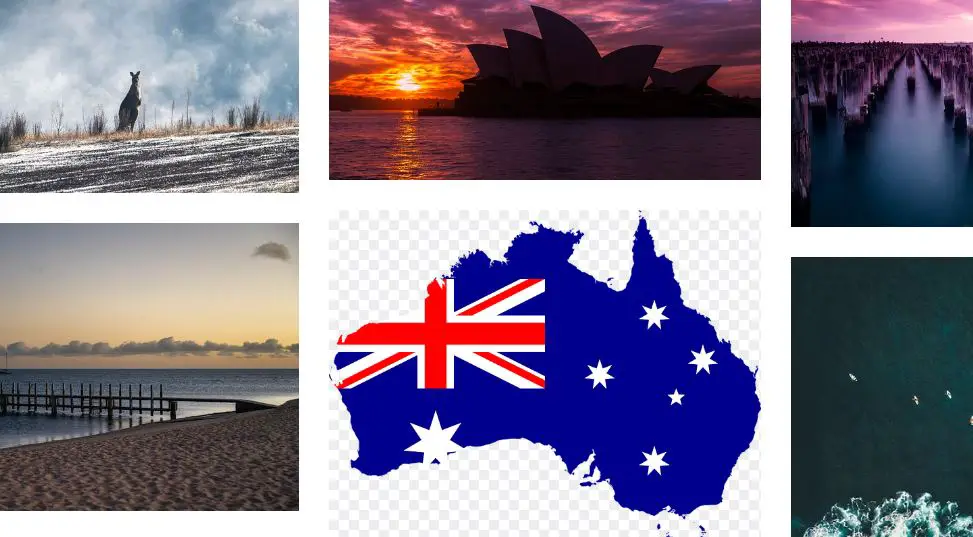
Welcome to Australia. If you are planning to visit Australia and you want to know about the List of famous best cities in Australia to visit then you have come to the right place. we have listed top 12 major cities in Australia to visit.
Australia, known for its stunning landscapes and diverse culture, is home to some of the most beautiful cities and towns in the world. From vibrant metropolises to charming coastal gems, this blog will unveil the top destinations that epitomize Australia’s natural and architectural splendor.
Whether you’re seeking breathtaking beaches, mesmerizing urban skylines, or historic charm, join us as we explore the best towns and cities that will leave you in awe. Prepare to be enchanted by Australia’s incredible beauty and discover your next bucket-list destination. Let’s dive into our list of the top 12 most beautiful cities in Australia!
Highlights:
- Best Time to Visit Australia: September to November | March to May
- High Tourist Season: Christmas through the end of January | April to September
- Low Season: October to March
Best Towns to Visit in Australia
1. SYDNEY- New South Wales
Sydney is a vibrant and bustling city located in Australia. It is known for its iconic landmarks, beautiful beaches, and diverse culture. If you’re planning a visit to Sydney, here are some things you should know:
-
- Best time to visit: Sydney enjoys a mild climate throughout the year, but the best time to visit is during the spring (September to November) and autumn (March to May) seasons when the weather is pleasant and there are fewer crowds.
- Getting there: Sydney is well connected internationally, and the Sydney Kingsford Smith Airport (SYD) is the main gateway to the city. From the airport, you can take a train, bus, or taxi to reach your destination.
- Accommodation: Sydney offers a wide range of accommodation options, including luxury hotels, budget-friendly hostels, and vacation rentals. The most popular areas to stay in Sydney include the CBD (Central Business District), Darling Harbour, Circular Quay, and Bondi Beach.
- Transportation: Sydney has an extensive public transportation system that includes trains, buses, ferries, and light rail. The Opal card is a convenient way to pay for public transport, and it can be used on all modes of transportation within the city.
- Top attractions: Sydney Opera House and Sydney Harbour Bridge are two of the most famous landmarks in the city. Other popular attractions include Bondi Beach, Taronga Zoo, Darling Harbour, Royal Botanic Garden, and The Rocks.
- Outdoor activities: Sydney offers plenty of outdoor activities for nature enthusiasts. You can take coastal walks along the stunning coastline, go surfing at Bondi Beach, explore national parks like Royal National Park and Blue Mountains, or take a ferry ride to Manly or Watsons Bay.
- Cultural experiences: Sydney has a vibrant arts and culture scene. You can catch a show at the Sydney Opera House, visit the Art Gallery of New South Wales, explore the vibrant neighborhoods like Newtown and Surry Hills, and indulge in multicultural cuisines at the various restaurants and food markets.
- Day trips: If you have extra time, consider taking day trips from Sydney to explore the surrounding areas. Some popular options include the Blue Mountains, Hunter Valley wine region, Jenolan Caves, and Port Stephens.
- Safety: Sydney is generally a safe city to visit, but it’s always a good idea to take standard safety precautions. Keep an eye on your belongings, be cautious in crowded areas, and follow any local guidelines or advice.
2. MELBOURNE- – Victoria
Melbourne is a cosmopolitan city located in the state of Victoria, Australia. It is known for its thriving arts and culture scene, diverse culinary offerings, and beautiful architecture. If you’re planning a trip to Melbourne, here are some things to keep in mind: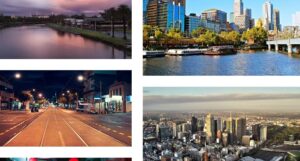
- Best time to visit: Melbourne experiences a temperate climate with distinct seasons. The months from December to February constitute summer and are generally warm. Autumn (March to May) and spring (September to November) offer milder temperatures, while winter (June to August) can be cool and rainy. Consider your preferred weather and events happening in the city when planning your visit.
- Getting there: Melbourne has its own international airport, Tullamarine Airport (MEL), which serves both domestic and international flights. From the airport, you can reach the city center by taking a taxi, rideshare service, or the SkyBus, which offers regular transfers to the city.
- Accommodation: Melbourne offers a wide range of accommodation options to suit various budgets and preferences. The city center and areas like Southbank, Fitzroy, and St Kilda are popular choices for tourists due to their proximity to attractions and amenities.
- Transportation: Melbourne has an efficient public transportation system that includes trams, trains, and buses. The city’s Free Tram Zone in the central area allows you to travel around without any cost. You can also purchase a myki card to access public transport services throughout the city and surrounding areas.
- Top attractions: Melbourne offers numerous attractions to explore. Some popular highlights include Federation Square, Flinders Street Station, the Royal Botanic Gardens, National Gallery of Victoria, Melbourne Museum, Queen Victoria Market, and the vibrant laneways and street art in the city center.
- Food and dining: Melbourne is known for its thriving food scene and diverse culinary offerings. From trendy cafes and restaurants to bustling food markets, you’ll find a wide range of cuisines to indulge in. Don’t miss trying the city’s famous coffee culture and exploring the multicultural dining options.
- Cultural experiences: Melbourne is often referred to as the cultural capital of Australia. You can immerse yourself in arts and culture by visiting the Melbourne Arts Precinct, which includes venues like the Arts Centre Melbourne and the National Gallery of Victoria. The city also hosts numerous festivals, live music events, and theatrical performances throughout the year.
- Sports: Melbourne is renowned for its passion for sports. If you’re a sports enthusiast, catch a cricket match at the Melbourne Cricket Ground (MCG) or watch Australian Rules Football (AFL) at one of the city’s stadiums. You can also take a tour of the sports venues to learn about their history and significance.
- Day trips: If you have extra time, consider taking day trips from Melbourne to explore the surrounding regions. You can visit the stunning Great Ocean Road, the picturesque Yarra Valley wine region, the charming Mornington Peninsula, or the historic gold rush town of Ballarat.
Watch Australia Hd video:
3. GOLD COAST- Queensland
Gold Coast is a popular tourist destination located in Queensland, Australia. Known for its beautiful beaches, theme parks, and vibrant nightlife, Gold Coast offers a range of activities and attractions for visitors. Here’s some information to help you plan your visit:
- Best time to visit: Gold Coast enjoys a sub-tropical climate, making it a great destination to visit year-round. The peak tourist season is during summer (December to February), but spring (September to November) and autumn (March to May) offer pleasant temperatures and fewer crowds.
- Getting there: Gold Coast is served by the Gold Coast Airport (OOL), which receives domestic and limited international flights. Alternatively, you can fly into Brisbane Airport (BNE) and take a shuttle or train to the Gold Coast, which is approximately an hour’s drive away.
- Accommodation: Gold Coast offers a range of accommodation options to suit different budgets and preferences. You can choose from luxury resorts, hotels, apartments, or beachfront holiday rentals. Popular areas to stay include Surfers Paradise, Broadbeach, Main Beach, and Burleigh Heads.
- Transportation: Gold Coast has an efficient public transportation system, including buses and trams, operated by TransLink. The G:link tram system runs along the coast, providing easy access to various attractions. Hiring a car or using rideshare services is also convenient for getting around.
- Beaches: Gold Coast is renowned for its beautiful sandy beaches and crystal-clear waters. Surfers Paradise Beach is the most famous and offers a vibrant atmosphere with numerous dining and entertainment options. Other popular beaches include Broadbeach, Burleigh Heads, and Coolangatta.
- Theme Parks: Gold Coast is home to several world-class theme parks that offer fun and excitement for all ages. Dreamworld, Warner Bros. Movie World, Sea World, and Wet’n’Wild are popular choices. Consider purchasing multi-park passes to save money if you plan to visit multiple parks.
- Hinterland: Just a short drive from the coast, Gold Coast Hinterland offers a contrasting experience with its lush rainforests, waterfalls, and hiking trails. Explore Lamington National Park, Springbrook National Park, and Tamborine Mountain for breathtaking views and natural beauty.
- Surfers Paradise: Surfers Paradise is the heart of Gold Coast’s entertainment scene. It features a vibrant nightlife with clubs, bars, and restaurants, along with shopping precincts like Cavill Avenue. The area also hosts events and festivals throughout the year.
- Outdoor activities: In addition to the beaches, Gold Coast offers various outdoor activities. You can go surfing, kayaking, jet skiing, or take a scenic boat tour. The region is also known for its golf courses and offers opportunities for bushwalking, cycling, and wildlife encounters.
4. BRISBANE- Queensland
Brisbane, the capital city of Queensland, Australia, is a vibrant and popular destination for visitors. Known for its sunny climate, beautiful riverfront, and laid-back atmosphere, Brisbane offers a range of attractions and activities to explore. Here’s some information to help you plan your visit to Brisbane: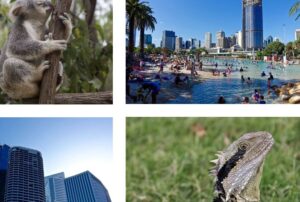
- Getting there: Brisbane has its own international airport, Brisbane Airport (BNE), which serves as a major gateway to the city. It’s well-connected with domestic and international flights. You can also reach Brisbane by train, bus, or car from other parts of Australia.
- Weather: Brisbane enjoys a subtropical climate with warm to hot summers and mild winters. Summers (December to February) can be humid, with temperatures ranging from 25°C to 35°C (77°F to 95°F). Winters (June to August) are mild, with temperatures around 15°C to 25°C (59°F to 77°F).
- Things to do:
- South Bank Parklands: This riverside area offers beautiful parklands, swimming lagoons, restaurants, and cultural institutions like the Queensland Art Gallery and the Gallery of Modern Art.
- Lone Pine Koala Sanctuary: Located just outside the city, this sanctuary is a great place to see and interact with koalas, kangaroos, and other Australian wildlife.
- Queensland Museum: Discover the natural and cultural heritage of Queensland through interactive exhibits, including dinosaur fossils, indigenous artifacts, and science displays.
- Story Bridge Adventure Climb: For a thrilling experience and panoramic views of the city, you can climb the iconic Story Bridge under the guidance of trained professionals.
- River cruises: Take a leisurely cruise along the Brisbane River to enjoy the city’s skyline and admire the landmarks.
- Mt. Coot-tha: Visit this scenic lookout to enjoy panoramic views of Brisbane, explore the botanic gardens, and have a meal at the Summit Restaurant.
- Cultural experiences:
- Explore the vibrant arts scene at the Queensland Performing Arts Centre (QPAC), which hosts theater productions, concerts, and dance performances.
- Visit the Queensland Gallery of Modern Art (GOMA) to see contemporary and modern artworks from Australia and around the world.
- Check out the vibrant nightlife in Fortitude Valley, where you’ll find a range of bars, live music venues, and nightclubs.
- Day trips: Brisbane is a great base for exploring the surrounding regions of Queensland. You can take day trips to the Gold Coast, Sunshine Coast, Moreton Island, or the scenic hinterland areas like Tamborine Mountain or the Glass House Mountains.
5. ADELAIDE- South Australia
Adelaide, the capital city of South Australia, is a charming and culturally rich destination that offers a blend of history, art, nature, and great food and wine. Here’s some information to help you plan your trip to Adelaide: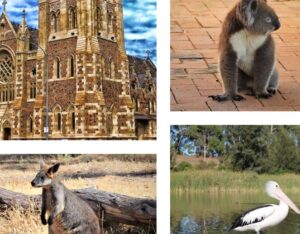
- Getting there: Adelaide has its own international airport, Adelaide Airport (ADL), which is well-connected to domestic and international destinations. You can also reach Adelaide by train, bus, or car from other parts of Australia.
- Weather: Adelaide experiences a Mediterranean climate with hot, dry summers and mild, wet winters. Summers (December to February) have temperatures ranging from 25°C to 35°C (77°F to 95°F), while winters (June to August) are milder with temperatures around 8°C to 16°C (46°F to 61°F).
- Things to do:
- Adelaide Botanic Garden: Explore the beautiful gardens, including the Bicentennial Conservatory and the Palm House, and enjoy a relaxing stroll through the lush greenery.
- Adelaide Central Market: Visit the bustling market to experience a wide range of fresh produce, gourmet food, and local products.
- Art Gallery of South Australia: Discover an impressive collection of Australian, European, and Asian art, including indigenous works and temporary exhibitions.
- Adelaide Zoo: Get up close with native Australian animals and exotic species, including pandas, tigers, and giraffes.
- Adelaide Hills: Take a scenic drive to the Adelaide Hills region, known for its picturesque landscapes, charming towns, wineries, and the Mount Lofty Summit with stunning panoramic views.
- Glenelg Beach: Enjoy a day at the beach in the suburb of Glenelg, where you can swim, sunbathe, and stroll along the vibrant Jetty Road with its shops, cafes, and restaurants.
- Wine regions: Adelaide is surrounded by renowned wine regions, including the Barossa Valley, McLaren Vale, and Adelaide Hills. Consider taking a day trip to explore the vineyards, taste local wines, and indulge in gourmet food.
- Festivals and events: Adelaide is known for its lively events and festivals. The Adelaide Fringe Festival, WOMADelaide (World of Music, Arts, and Dance), and the Adelaide Festival of Arts are just a few examples of the vibrant cultural scene.
- Cultural experiences:
- Visit the National Wine Centre of Australia to learn about the country’s wine industry and enjoy wine tastings.
- Explore the history and heritage of Adelaide at the Migration Museum, South Australian Museum, and the State Library of South Australia.
- Take a guided tour or explore independently to appreciate Adelaide’s well-preserved colonial architecture and heritage sites, such as the Adelaide Oval, Parliament House, and the Adelaide Town Hall.
- Day trips: Consider taking day trips from Adelaide to nearby destinations such as Kangaroo Island, a wildlife haven; the historic German village of Hahndorf; or the scenic Flinders Ranges.
- Safety and practical tips: Adelaide is generally a safe city, but it’s always wise to take precautions such as keeping an eye on your belongings and being aware of your surroundings. Stay hydrated, wear sunscreen, and carry insect repellent when exploring outdoor areas. It’s also a good idea to check the latest travel advisories and the opening hours of attractions and accommodations before your visit.
6. CAIRNS- Queensland
Cairns is a popular tourist destination located in Queensland, Australia. It is known for its tropical climate, stunning natural beauty, and access to the Great Barrier Reef. If you’re planning a trip to Cairns, here are some things you should know: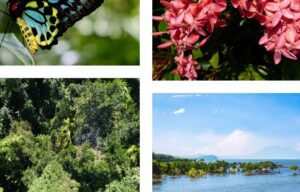
- Best Time to Visit: Cairns has a tropical climate, so the best time to visit is during the dry season, which runs from April to October. The weather is pleasant with less rainfall during this time, making it ideal for outdoor activities.
- Great Barrier Reef: Cairns is the gateway to the Great Barrier Reef, one of the world’s most remarkable natural wonders. There are various tour operators offering snorkeling and scuba diving trips to explore the vibrant coral reefs and marine life.
- Daintree Rainforest: Cairns is also close to the Daintree Rainforest, the oldest tropical rainforest in the world. You can take guided tours to explore its lush greenery, spot wildlife, and take a cruise along the Daintree River.
- Kuranda: A visit to Cairns is incomplete without experiencing Kuranda, a charming village located in the rainforest. You can reach Kuranda via the scenic Kuranda Scenic Railway or the Skyrail Rainforest Cableway. The village is known for its markets, wildlife parks, and stunning views.
- Outdoor Activities: Cairns offers a wide range of outdoor activities, including hiking, biking, kayaking, and white-water rafting. You can explore the surrounding national parks, such as Barron Gorge National Park and Mossman Gorge, for thrilling adventures and breathtaking scenery.
- Cairns Esplanade: The Cairns Esplanade is a popular waterfront promenade where you can relax, swim in the lagoon, or enjoy a picnic. It’s a great place to soak up the sun, and it also has BBQ facilities and a skate park.
- Indigenous Culture: Cairns provides opportunities to learn about the local Indigenous culture. You can visit the Tjapukai Aboriginal Cultural Park to experience traditional dances, art, and music. There are also various Indigenous-guided tours available.
- Food and Nightlife: Cairns offers a vibrant dining scene with numerous restaurants and cafes serving a variety of cuisines, including fresh seafood. The city also has a bustling nightlife, with bars, clubs, and night markets where you can enjoy live music and entertainment.
- Safety and Wildlife: While Cairns is generally a safe destination, it’s important to be cautious of the tropical environment. Follow safety guidelines, especially when swimming or snorkeling. Be aware of wildlife such as crocodiles and stinging jellyfish in certain areas and adhere to local warnings and instructions.
- Transportation: Cairns has its own airport, making it easily accessible by air. The city has a well-connected public transportation system, including buses and taxis, to help you get around. Car rentals are also available if you prefer to explore at your own pace.
7. DARWIN- Northern Territory
Darwin is the capital city of the Northern Territory in Australia and offers a unique blend of natural beauty, multiculturalism, and rich Indigenous heritage. If you’re planning a trip to Darwin, here’s some information to help you:
- Best Time to Visit: Darwin has a tropical climate with two distinct seasons – the wet season (November to April) and the dry season (May to October). The dry season is the most popular time to visit, as the weather is warm and pleasant, and there is less rainfall.
- Kakadu National Park: One of the major attractions near Darwin is Kakadu National Park, a UNESCO World Heritage site. It’s known for its stunning landscapes, diverse wildlife, and ancient Aboriginal rock art. You can take guided tours to explore the park’s waterfalls, wetlands, and escarpments.
- Litchfield National Park: Another nearby destination is Litchfield National Park, famous for its waterfalls, swimming holes, and unique magnetic termite mounds. It’s a great place for bushwalking, picnicking, and swimming in natural pools.
- Indigenous Culture: Darwin provides opportunities to learn about the local Indigenous culture. The Museum and Art Gallery of the Northern Territory and the Darwin Aboriginal Art Fair showcase Indigenous art, history, and culture. You can also take cultural tours to gain insights into the traditions and customs of the local Aboriginal people.
- Mindil Beach Sunset Market: The Mindil Beach Sunset Market is a must-visit attraction in Darwin. It operates during the dry season and offers a vibrant atmosphere with food stalls, arts and crafts, live entertainment, and stunning sunset views over the Timor Sea.
- Crocosaurus Cove: For a unique wildlife experience, visit Crocosaurus Cove in Darwin’s city center. Here, you can get up close and personal with saltwater crocodiles, hold baby crocs, and even swim in the “Cage of Death” for an adrenaline-pumping encounter.
- Darwin Waterfront Precinct: The Darwin Waterfront Precinct is a popular area with a wave pool, lagoon, recreational spaces, restaurants, and cafes. It’s a great place to relax, swim, dine, and enjoy the waterfront ambiance.
- Military History: Darwin has a significant military history, particularly during World War II. You can visit the Darwin Military Museum, East Point Military Museum, and other historical sites to learn about the city’s involvement and explore the remnants of the wartime defenses.
- Asian Influence: Darwin has a strong Asian influence due to its proximity to Southeast Asia. You’ll find a wide range of Asian cuisines, night markets, and festivals that celebrate the multicultural aspect of the city.
- Outdoor Adventures: Darwin is a gateway to various outdoor adventures. You can go fishing, boating, or sailing in the pristine waters, take a crocodile-spotting cruise along the Adelaide River, or even go on a scenic helicopter ride to get a bird’s-eye view of the stunning landscapes.
8. PERTH- – Western Australia
Perth, the capital city of Western Australia, is a vibrant and modern destination known for its beautiful beaches, sunny weather, and thriving arts and culinary scenes. If you’re planning a trip to Perth, here’s some information to help you: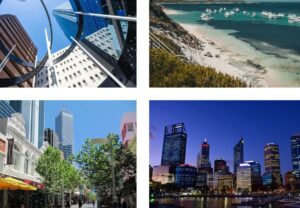
- Best Time to Visit: Perth enjoys a Mediterranean climate, with hot summers and mild winters. The best time to visit is during spring (September to November) and autumn (March to May) when the weather is pleasant, and there are fewer crowds.
- Beaches: Perth is renowned for its stunning coastline and pristine beaches. Some popular beaches include Cottesloe Beach, Scarborough Beach, and Trigg Beach. You can relax on the sandy shores, swim in crystal-clear waters, or even try your hand at surfing or paddleboarding.
- Swan Valley: Located just outside of Perth, Swan Valley is a wine region known for its vineyards, cellar doors, and gourmet food. Take a day trip to explore the wineries, sample local wines, indulge in delicious cuisine, and enjoy the picturesque scenery.
- Kings Park and Botanic Garden: Kings Park is one of the largest city parks in the world and offers sweeping views of Perth’s skyline, the Swan River, and the surrounding landscapes. You can take leisurely walks, have picnics, explore the botanic gardens, and visit the Lotterywest Federation Walkway for an elevated treetop experience.
- Fremantle: A visit to Perth is incomplete without exploring Fremantle, a vibrant port city located just south of Perth. It’s known for its historic buildings, lively markets, and eclectic arts scene. Take a stroll along the famous Cappuccino Strip, visit the Fremantle Prison, and explore the Fremantle Markets.
- Rottnest Island: A short ferry ride from Perth, Rottnest Island is a paradise for nature lovers and beach enthusiasts. It’s home to the adorable quokkas, and you can hire bikes to explore the island, snorkel in the crystal-clear waters, and relax on the idyllic beaches.
- Cultural Experiences: Perth has a thriving arts and cultural scene. You can visit the Art Gallery of Western Australia, the Perth Cultural Centre, or catch a performance at the Perth Concert Hall or State Theatre Centre. The Perth International Arts Festival, held annually, showcases a diverse range of artistic talent.
- Swan River: The Swan River flows through the heart of Perth and offers various recreational activities. You can take a scenic river cruise, hire a kayak or paddleboard, or simply enjoy a picnic along the riverbanks.
- Wildlife Encounters: Perth and its surrounding areas provide opportunities for wildlife encounters. You can visit the Perth Zoo to see native and exotic animals, take a dolphin-watching cruise in the waters off Rockingham, or visit Caversham Wildlife Park to interact with kangaroos, koalas, and other Australian wildlife.
- Food and Dining: Perth has a burgeoning food scene, with numerous restaurants, cafes, and food markets offering diverse cuisines. You can explore Northbridge for multicultural dining experiences, try fresh seafood at the Fishing Boat Harbour in Fremantle, or visit the Twilight Hawkers Market for a taste of international street food.
9. ALICE SPRINGS-
Alice Springs is a town located in the heart of Australia’s Red Centre, in the Northern Territory. It is known for its unique Outback landscapes, Indigenous culture, and proximity to iconic natural attractions like Uluru (Ayers Rock) and Kata Tjuta (the Olgas). If you’re planning a trip to Alice Springs, here’s some information to help you: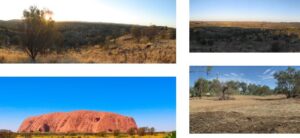
- Best Time to Visit: The best time to visit Alice Springs is during the cooler months, from April to September, when temperatures are more comfortable. However, be prepared for chilly nights, as the desert climate can have significant temperature drops after sunset.
- Uluru and Kata Tjuta: Alice Springs is the gateway to Uluru-Kata Tjuta National Park, home to the famous Uluru and Kata Tjuta rock formations. You can take guided tours or self-drive to these iconic landmarks, witness stunning sunrises and sunsets, and learn about the cultural significance of these sites to the local Aboriginal people.
- West MacDonnell Ranges: The West MacDonnell Ranges are a range of ancient red rock formations located near Alice Springs. Explore the gorges, waterholes, and hiking trails such as Simpsons Gap, Standley Chasm, and Ormiston Gorge. Don’t miss the chance to swim in the picturesque Ellery Creek Big Hole.
- Aboriginal Culture: Alice Springs offers opportunities to immerse yourself in Aboriginal culture. Visit the Alice Springs Desert Park to learn about the local Indigenous flora, fauna, and traditional knowledge. You can also visit local art galleries, attend cultural events, or take guided tours to gain insights into the rich Aboriginal heritage of the region.
- Alice Springs Telegraph Station: Discover the historical significance of the Alice Springs Telegraph Station, which played a vital role in connecting Australia with the rest of the world. Explore the museum, walk the heritage trail, and learn about the challenges faced by early telegraph operators in the harsh Outback.
- Camel Riding: Experience a unique mode of transportation by going on a camel ride in the desert. Several operators offer guided tours where you can enjoy the scenic landscapes while riding these iconic animals.
- Reptile and Wildlife Experiences: Get up close and personal with Australia’s unique wildlife at the Alice Springs Reptile Centre. You can see and learn about a variety of reptiles, including snakes, lizards, and the famous Australian saltwater crocodiles.
- Hot Air Ballooning: Witness the stunning Outback landscapes from above by going on a hot air balloon ride. Float above the rugged terrain at sunrise and enjoy panoramic views of the surrounding red desert and mountain ranges.
- Aboriginal Art: Alice Springs is a hub for Indigenous art, and you can visit art galleries to admire and purchase beautiful Aboriginal artworks. The Desert Mob exhibition, held annually in September, showcases artworks from artists in Central Australia and is a highlight for art enthusiasts.
- Stargazing: With its clear night skies, Alice Springs is a fantastic place for stargazing. Join a guided tour or visit the Desert Park’s outdoor amphitheater for an unforgettable experience of the southern hemisphere’s stars and constellations.
10. BYRON BAY- New South Wales
Byron Bay, located in New South Wales, Australia, is a popular coastal town known for its pristine beaches, laid-back atmosphere, and alternative lifestyle. If you’re planning a trip to Byron Bay, here’s some information to help you: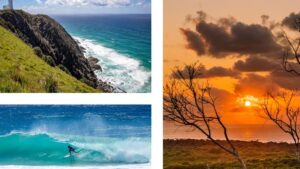
- Best Time to Visit: Byron Bay has a subtropical climate, with mild winters and warm summers. The best time to visit is during spring (September to November) and autumn (March to May) when the weather is pleasant, and there are fewer crowds.
- Beaches: Byron Bay is famous for its stunning beaches. Main Beach is the town’s main beach, located near the town center. Other popular beaches include Wategos Beach, Tallows Beach, and The Pass. Enjoy swimming, surfing, sunbathing, or simply taking leisurely walks along the sandy shores.
- Cape Byron Lighthouse: Located at Cape Byron, the Cape Byron Lighthouse is an iconic landmark and offers panoramic views of the coastline. You can take a walk along the Cape Byron Walking Track, spot dolphins or whales (during the migration season), and enjoy breathtaking sunrises or sunsets from this picturesque spot.
- Byron Bay Hinterland: Explore the lush hinterland surrounding Byron Bay, which offers stunning natural beauty and quaint villages. Visit places like Bangalow, Mullumbimby, and the Crystal Castle and Shambhala Gardens. Take scenic drives, go on bushwalks, and immerse yourself in the tranquil countryside.
- Byron Bay Markets: The Byron Bay Community Market and the Byron Bay Farmers Market are popular attractions. Browse through stalls selling local crafts, clothing, jewelry, fresh produce, and indulge in delicious food and live music.
- Alternative and Wellness Culture: Byron Bay has a vibrant alternative and wellness culture. You’ll find numerous yoga studios, wellness retreats, vegetarian and vegan cafes, and shops offering organic and eco-friendly products. Embrace the relaxed and holistic vibe of the town by participating in yoga classes, wellness workshops, or visiting a day spa.
- Nightlife and Entertainment: Byron Bay has a lively nightlife scene with various bars, live music venues, and clubs. Enjoy live music performances, dance the night away, or simply relax with a drink and soak up the atmosphere.
- Outdoor Activities: Byron Bay is a haven for outdoor enthusiasts. You can go snorkeling or scuba diving at Julian Rocks Marine Reserve, try kayaking or stand-up paddleboarding, go on whale-watching tours (seasonal), or take part in eco-adventures like surfing lessons or skydiving.
- Byron Bay Lighthouse Trail: Embark on the Byron Bay Lighthouse Trail, a scenic coastal walk that takes you from the town center to the lighthouse. Enjoy breathtaking ocean views, spot wildlife along the way, and learn about the area’s history and ecology through informative signs.
- Byron Bay Bluesfest: If you’re visiting during Easter, don’t miss the Byron Bay Bluesfest, a renowned music festival featuring local and international artists across various genres.
11. HOBART- Tasmania
Hobart, the capital city of Tasmania, is a charming and picturesque destination known for its rich history, stunning landscapes, and vibrant arts and culinary scene. If you’re planning a trip to Hobart, here’s some information to help you: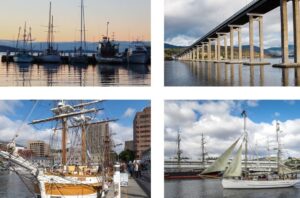
- Best Time to Visit: Hobart has a mild maritime climate. The summer months of December to February offer the warmest weather, while autumn (March to May) and spring (September to November) provide pleasant temperatures and beautiful foliage. Keep in mind that Tasmania’s weather can be unpredictable, so it’s always a good idea to layer your clothing.
- Salamanca Market: The Salamanca Market is a popular attraction in Hobart. Held every Saturday along Salamanca Place, it features over 300 stalls selling local produce, arts and crafts, clothing, and more. Enjoy live music, indulge in delicious food, and immerse yourself in the vibrant atmosphere.
- Battery Point: Explore the historic neighborhood of Battery Point, characterized by its charming Georgian architecture, narrow streets, and quaint cottages. Visit the Narryna Heritage Museum, St. George’s Anglican Church, and take a stroll to admire the scenic views of the harbor.
- MONA (Museum of Old and New Art): A visit to Hobart is incomplete without exploring MONA, one of the world’s most unique and controversial museums. This underground museum showcases a wide range of thought-provoking contemporary and ancient art. Access MONA by ferry along the Derwent River for a scenic experience.
- Mount Wellington: Enjoy panoramic views of Hobart and its surrounding landscapes by visiting Mount Wellington. You can drive or take a shuttle bus to the summit, where you’ll find walking tracks, lookouts, and opportunities for photography. Be prepared for colder temperatures and strong winds at the top.
- Port Arthur: Take a day trip from Hobart to Port Arthur, a historic site and former penal colony. Explore the well-preserved buildings, learn about Australia’s convict past, and take a guided tour to fully appreciate the history and haunting beauty of the area.
- Tasmanian Museum and Art Gallery: Discover Tasmania’s natural and cultural heritage at the Tasmanian Museum and Art Gallery. From natural history exhibits to Tasmanian Aboriginal artifacts and contemporary art, the museum provides insights into the island’s diverse history and culture.
- Cascade Brewery: Visit Australia’s oldest continuously operating brewery, the Cascade Brewery, located just outside of Hobart. Take a guided tour to learn about the brewing process, explore the beautiful gardens, and sample their renowned beers.
- Bruny Island: Take a day trip to Bruny Island, accessible by a short ferry ride from Hobart. This island offers pristine beaches, stunning coastal cliffs, abundant wildlife, and delicious local produce. Go on a wildlife tour, visit the lighthouse, and enjoy the serene natural surroundings.
- Food and Wine: Hobart is known for its exceptional food and wine scene. Explore the city’s numerous restaurants, cafes, and bars, showcasing the best of Tasmanian produce. Don’t miss the opportunity to try fresh seafood, locally sourced ingredients, and sample the renowned cool-climate wines of the region.
12. CANBERRA- Australian Capital Territory
Canberra, located in the Australian Capital Territory (ACT), is the capital city of Australia. Known for its well-planned layout, iconic landmarks, and rich cultural offerings, Canberra is an excellent destination for history, art, and nature enthusiasts. If you’re planning a trip to Canberra, here’s some information to help you: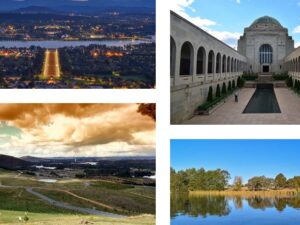
- Best Time to Visit: Canberra experiences four distinct seasons. Spring (September to November) and autumn (March to May) offer mild and pleasant weather, making them ideal times to visit. Summers (December to February) can be hot, while winters (June to August) are cold, with occasional snowfall in the surrounding mountains.
- National Institutions: Canberra is home to numerous national institutions and museums, which provide insights into Australia’s history, art, and culture. Some must-visit institutions include the Australian War Memorial, National Gallery of Australia, National Museum of Australia, and Parliament House. Explore their exhibitions, attend guided tours, and learn about the nation’s heritage.
- Lake Burley Griffin: The centerpiece of Canberra, Lake Burley Griffin, offers a picturesque setting for outdoor activities. Take a leisurely walk or bike ride along the lake’s foreshore, rent a paddleboat or kayak, or simply relax and enjoy the stunning views of the surrounding landmarks.
- Australian National Botanic Gardens: Immerse yourself in the natural beauty of the Australian National Botanic Gardens. Discover a diverse range of native plants, stroll through various themed gardens, and enjoy the peaceful ambiance. The gardens also offer guided walks, talks, and events throughout the year.
- Australian Parliament House: Take a guided tour of the iconic Australian Parliament House, which showcases the workings of the Australian government. Explore the public areas, including the Great Hall, Senate and House of Representatives chambers, and the impressive art collection.
- Questacon: Visit Questacon, the National Science and Technology Centre, for a fun and interactive experience. Enjoy hands-on exhibits, science shows, and experiments that cater to visitors of all ages. It’s a fantastic place for families and those with an interest in science.
- Mount Ainslie Lookout: Drive or hike up to Mount Ainslie Lookout for a panoramic view of Canberra’s cityscape and surrounding natural landscapes. It’s an excellent spot for sunrise or sunset views and offers a different perspective of the city.
- National Arboretum Canberra: Explore the National Arboretum Canberra, a large parkland showcasing a vast collection of rare and endangered trees from around the world. Take leisurely walks through the forests, visit the bonsai collection, and enjoy the breathtaking views of Canberra from the lookout.
- Australian War Memorial: Pay your respects at the Australian War Memorial, a significant monument honoring the sacrifice of Australian servicemen and women. Explore the commemorative galleries, attend a moving Last Post Ceremony, and take in the serene beauty of the memorial’s grounds.
- Floriade: If you visit in spring, don’t miss Floriade, Australia’s largest flower festival. Held annually, Floriade features over one million blooms in vibrant displays, along with music, cultural performances, and various activities for visitors of all ages.
Remember to plan your itinerary in advance, make necessary bookings for tours and accommodations, and check for any travel advisories or restrictions before your trip. Enjoy your visit to Cairns and make the most of the beautiful surroundings and unique experiences it has to offer!
Find Australia on Google Map
Which one is the best city in Australia and why?
Please leave a comment down.
Happy Traveling
Search Posts
Latest posts
-
4 Mar, 2024
How can I do a "broad" search for flights?
-
4 Mar, 2024
Why would you wrap your luggage in plastic?
Popular posts
-
5 Mar, 2024
Why prohibit engine braking?
-
5 Mar, 2024
How to avoid drinking vodka?